PSY/LAW 370 Research Paper: Gun Laws and Mass Shootings
VerifiedAdded on 2022/07/27
|10
|2677
|19
Report
AI Summary
This research paper investigates the primary causes of mass shootings in the United States, analyzing the roles of both faulty gun laws and mental illness. The paper begins by presenting the controversy surrounding the association of crowd gunfire with mental illness, noting that while psychologists often attribute such behaviors to mental instability, both the public and the legal system often perceive this association as unfounded. The paper explores the influence of the Brady Handgun Violence Prevention Act and the expansion of gun rights. The author argues that the unstrictness of gun ownership allows even the mentally ill to own firearms. The paper then proposes solutions, including redefinition of mental health firearm disqualification criteria, expansions on firearm rights restrictions, public mental health education, and community assessment programs. The paper concludes by reiterating the need for legal and psychological fields to collaborate to prevent mass shootings and the misuse of mental instability as a defense. The paper utilizes at least five peer-reviewed journal articles and adheres to APA format.
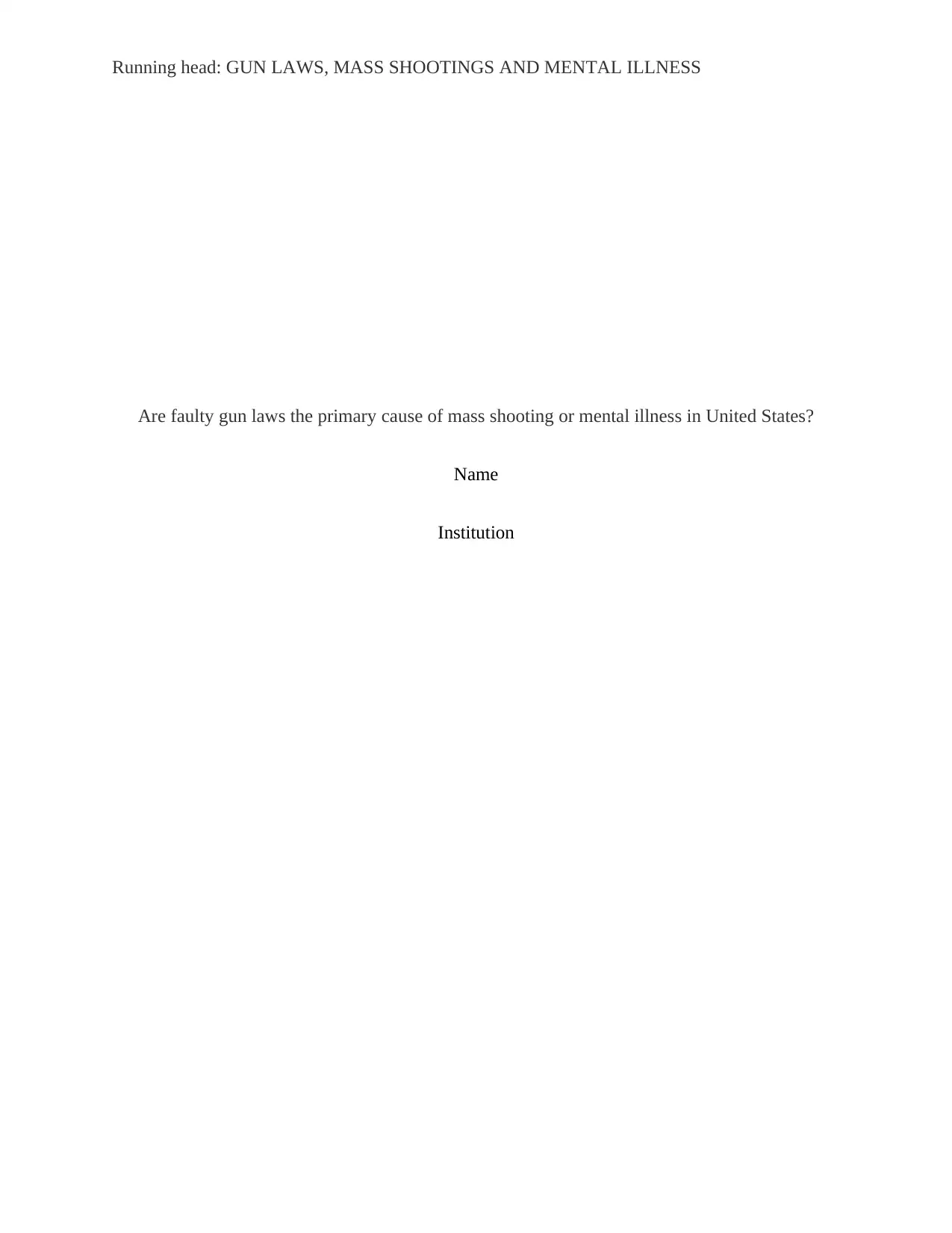
Running head: GUN LAWS, MASS SHOOTINGS AND MENTAL ILLNESS
Are faulty gun laws the primary cause of mass shooting or mental illness in United States?
Name
Institution
Are faulty gun laws the primary cause of mass shooting or mental illness in United States?
Name
Institution
Paraphrase This Document
Need a fresh take? Get an instant paraphrase of this document with our AI Paraphraser
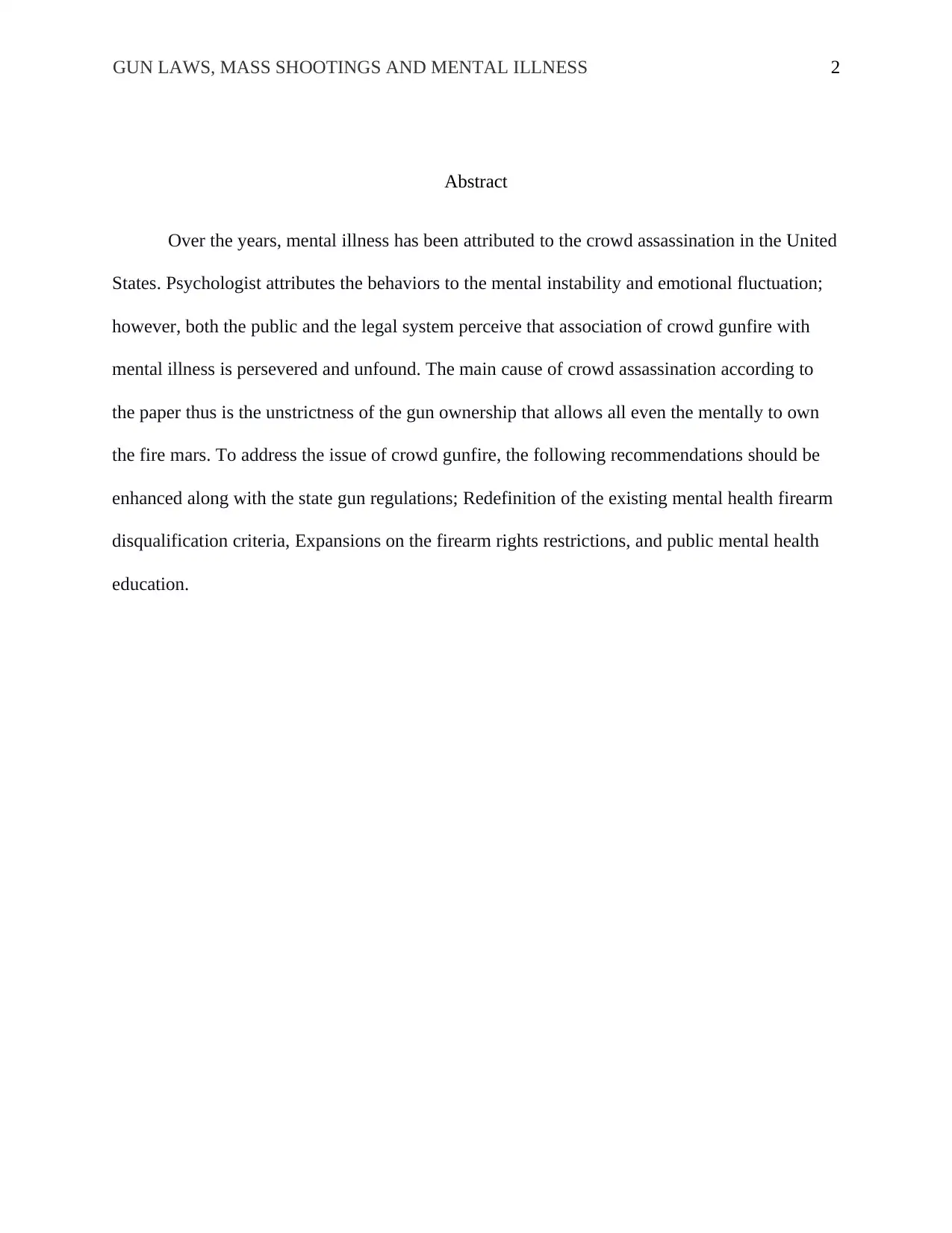
GUN LAWS, MASS SHOOTINGS AND MENTAL ILLNESS 2
Abstract
Over the years, mental illness has been attributed to the crowd assassination in the United
States. Psychologist attributes the behaviors to the mental instability and emotional fluctuation;
however, both the public and the legal system perceive that association of crowd gunfire with
mental illness is persevered and unfound. The main cause of crowd assassination according to
the paper thus is the unstrictness of the gun ownership that allows all even the mentally to own
the fire mars. To address the issue of crowd gunfire, the following recommendations should be
enhanced along with the state gun regulations; Redefinition of the existing mental health firearm
disqualification criteria, Expansions on the firearm rights restrictions, and public mental health
education.
Abstract
Over the years, mental illness has been attributed to the crowd assassination in the United
States. Psychologist attributes the behaviors to the mental instability and emotional fluctuation;
however, both the public and the legal system perceive that association of crowd gunfire with
mental illness is persevered and unfound. The main cause of crowd assassination according to
the paper thus is the unstrictness of the gun ownership that allows all even the mentally to own
the fire mars. To address the issue of crowd gunfire, the following recommendations should be
enhanced along with the state gun regulations; Redefinition of the existing mental health firearm
disqualification criteria, Expansions on the firearm rights restrictions, and public mental health
education.

GUN LAWS, MASS SHOOTINGS AND MENTAL ILLNESS 3
Are faulty gun laws the primary cause of mass shooting or mental illness in the United States?
Introduction
During the past decades, crowd gunfire events have been popular in the United States and
other parts of the world. While other cold killings grasp little interest from the people, crowd
gunfire incidents are tremendously noticeable as a result of little influence from the
policymaking that is reluctant to address the gun laws. Crowd assassinations can be defined as
the intentional killing of more than three people in one location. Just like when the recent pair of
crowd assassinations on Americans on a single weekend, President Donald Trump, while
addressing the public through the twitter account blamed mental illness and not the gun (Philpott,
2018). However, numerous psychiatrists have always blamed such incidence to mental illness.
The influence of insanity on irresponsible gun usage is rejected by law and justice system
even though the two fields interact and associate in numerous criminal cases. According to
studies, 60% of the crowd assassination perpetrators in the United States had been diagnosed by
different symptoms of mental illness such as depressions, delusions, and paranoia before such
committing such crimes. Therefore, it is undeniable that people with such symptoms should be
denied access to the gun that could cause to their own or other people’s harm. Such
contradictions thus pose different questions on ether the crowd assassinations are a result of the
faulty gun law or insanity in the United States. Mental illness represents a small percentage of
the cause of crowd assassinations, but the thirteen amendments make it typically easy to acquire
a gun.
Part A-Controversy
Are faulty gun laws the primary cause of mass shooting or mental illness in the United States?
Introduction
During the past decades, crowd gunfire events have been popular in the United States and
other parts of the world. While other cold killings grasp little interest from the people, crowd
gunfire incidents are tremendously noticeable as a result of little influence from the
policymaking that is reluctant to address the gun laws. Crowd assassinations can be defined as
the intentional killing of more than three people in one location. Just like when the recent pair of
crowd assassinations on Americans on a single weekend, President Donald Trump, while
addressing the public through the twitter account blamed mental illness and not the gun (Philpott,
2018). However, numerous psychiatrists have always blamed such incidence to mental illness.
The influence of insanity on irresponsible gun usage is rejected by law and justice system
even though the two fields interact and associate in numerous criminal cases. According to
studies, 60% of the crowd assassination perpetrators in the United States had been diagnosed by
different symptoms of mental illness such as depressions, delusions, and paranoia before such
committing such crimes. Therefore, it is undeniable that people with such symptoms should be
denied access to the gun that could cause to their own or other people’s harm. Such
contradictions thus pose different questions on ether the crowd assassinations are a result of the
faulty gun law or insanity in the United States. Mental illness represents a small percentage of
the cause of crowd assassinations, but the thirteen amendments make it typically easy to acquire
a gun.
Part A-Controversy
⊘ This is a preview!⊘
Do you want full access?
Subscribe today to unlock all pages.

Trusted by 1+ million students worldwide
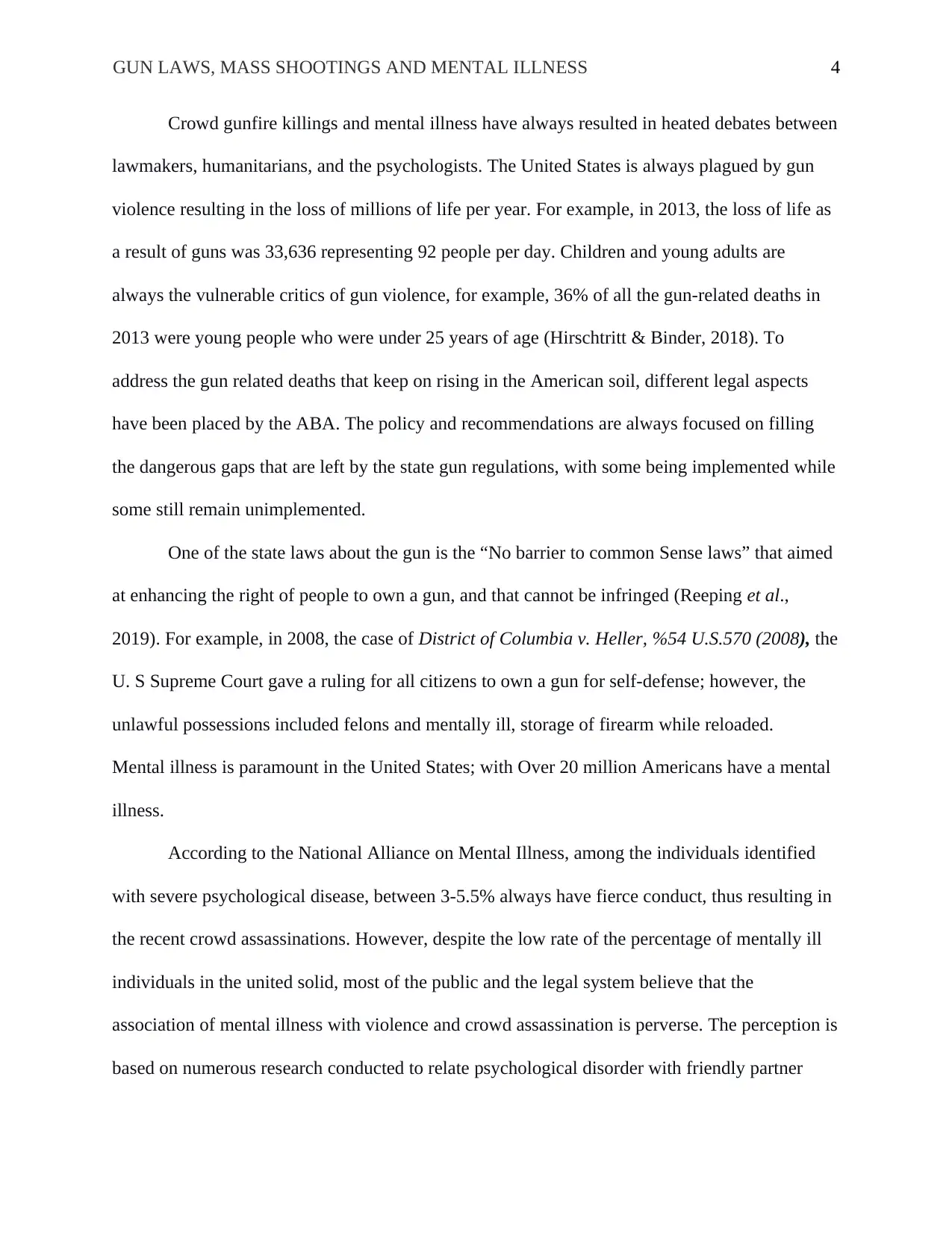
GUN LAWS, MASS SHOOTINGS AND MENTAL ILLNESS 4
Crowd gunfire killings and mental illness have always resulted in heated debates between
lawmakers, humanitarians, and the psychologists. The United States is always plagued by gun
violence resulting in the loss of millions of life per year. For example, in 2013, the loss of life as
a result of guns was 33,636 representing 92 people per day. Children and young adults are
always the vulnerable critics of gun violence, for example, 36% of all the gun-related deaths in
2013 were young people who were under 25 years of age (Hirschtritt & Binder, 2018). To
address the gun related deaths that keep on rising in the American soil, different legal aspects
have been placed by the ABA. The policy and recommendations are always focused on filling
the dangerous gaps that are left by the state gun regulations, with some being implemented while
some still remain unimplemented.
One of the state laws about the gun is the “No barrier to common Sense laws” that aimed
at enhancing the right of people to own a gun, and that cannot be infringed (Reeping et al.,
2019). For example, in 2008, the case of District of Columbia v. Heller, %54 U.S.570 (2008), the
U. S Supreme Court gave a ruling for all citizens to own a gun for self-defense; however, the
unlawful possessions included felons and mentally ill, storage of firearm while reloaded.
Mental illness is paramount in the United States; with Over 20 million Americans have a mental
illness.
According to the National Alliance on Mental Illness, among the individuals identified
with severe psychological disease, between 3-5.5% always have fierce conduct, thus resulting in
the recent crowd assassinations. However, despite the low rate of the percentage of mentally ill
individuals in the united solid, most of the public and the legal system believe that the
association of mental illness with violence and crowd assassination is perverse. The perception is
based on numerous research conducted to relate psychological disorder with friendly partner
Crowd gunfire killings and mental illness have always resulted in heated debates between
lawmakers, humanitarians, and the psychologists. The United States is always plagued by gun
violence resulting in the loss of millions of life per year. For example, in 2013, the loss of life as
a result of guns was 33,636 representing 92 people per day. Children and young adults are
always the vulnerable critics of gun violence, for example, 36% of all the gun-related deaths in
2013 were young people who were under 25 years of age (Hirschtritt & Binder, 2018). To
address the gun related deaths that keep on rising in the American soil, different legal aspects
have been placed by the ABA. The policy and recommendations are always focused on filling
the dangerous gaps that are left by the state gun regulations, with some being implemented while
some still remain unimplemented.
One of the state laws about the gun is the “No barrier to common Sense laws” that aimed
at enhancing the right of people to own a gun, and that cannot be infringed (Reeping et al.,
2019). For example, in 2008, the case of District of Columbia v. Heller, %54 U.S.570 (2008), the
U. S Supreme Court gave a ruling for all citizens to own a gun for self-defense; however, the
unlawful possessions included felons and mentally ill, storage of firearm while reloaded.
Mental illness is paramount in the United States; with Over 20 million Americans have a mental
illness.
According to the National Alliance on Mental Illness, among the individuals identified
with severe psychological disease, between 3-5.5% always have fierce conduct, thus resulting in
the recent crowd assassinations. However, despite the low rate of the percentage of mentally ill
individuals in the united solid, most of the public and the legal system believe that the
association of mental illness with violence and crowd assassination is perverse. The perception is
based on numerous research conducted to relate psychological disorder with friendly partner
Paraphrase This Document
Need a fresh take? Get an instant paraphrase of this document with our AI Paraphraser
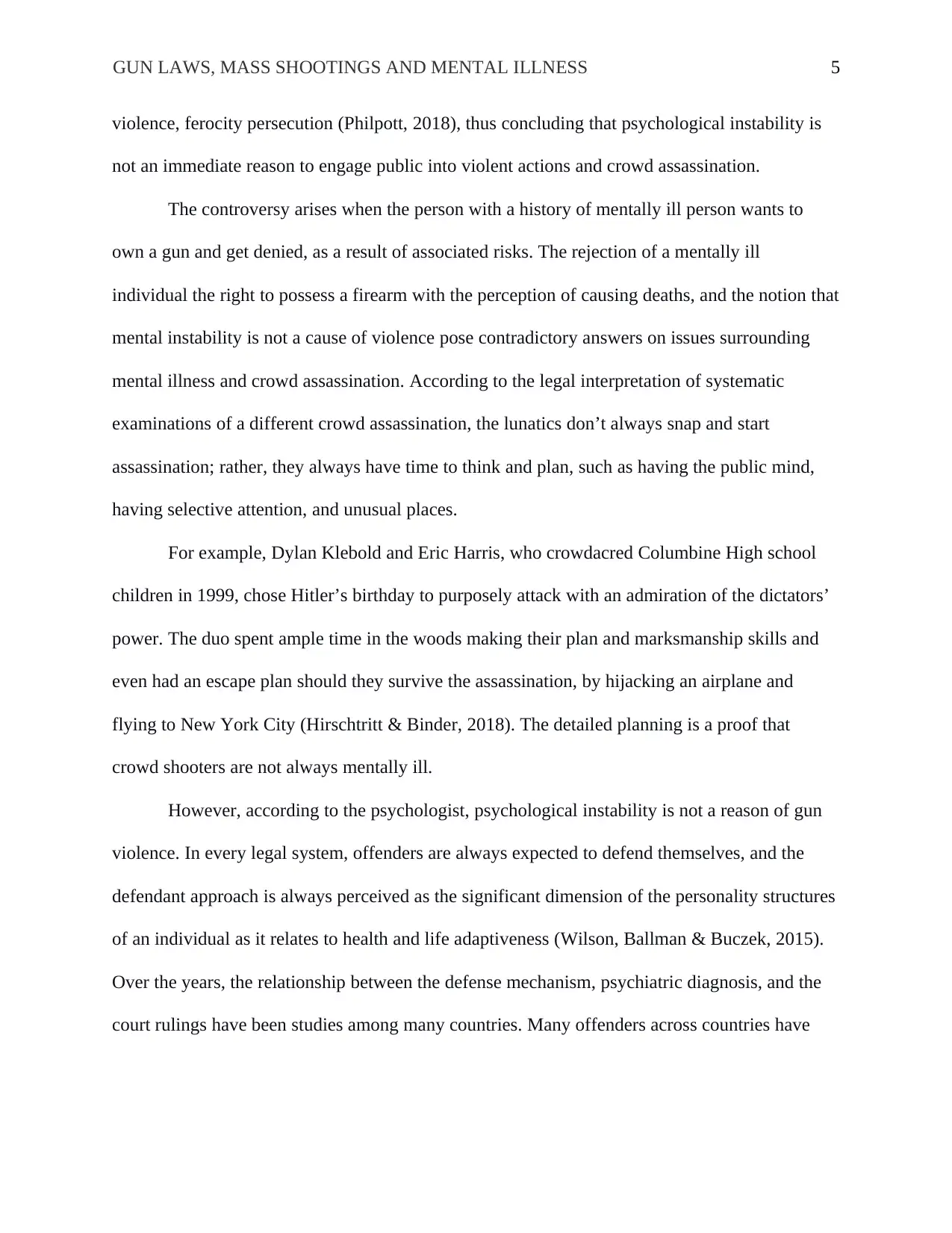
GUN LAWS, MASS SHOOTINGS AND MENTAL ILLNESS 5
violence, ferocity persecution (Philpott, 2018), thus concluding that psychological instability is
not an immediate reason to engage public into violent actions and crowd assassination.
The controversy arises when the person with a history of mentally ill person wants to
own a gun and get denied, as a result of associated risks. The rejection of a mentally ill
individual the right to possess a firearm with the perception of causing deaths, and the notion that
mental instability is not a cause of violence pose contradictory answers on issues surrounding
mental illness and crowd assassination. According to the legal interpretation of systematic
examinations of a different crowd assassination, the lunatics don’t always snap and start
assassination; rather, they always have time to think and plan, such as having the public mind,
having selective attention, and unusual places.
For example, Dylan Klebold and Eric Harris, who crowdacred Columbine High school
children in 1999, chose Hitler’s birthday to purposely attack with an admiration of the dictators’
power. The duo spent ample time in the woods making their plan and marksmanship skills and
even had an escape plan should they survive the assassination, by hijacking an airplane and
flying to New York City (Hirschtritt & Binder, 2018). The detailed planning is a proof that
crowd shooters are not always mentally ill.
However, according to the psychologist, psychological instability is not a reason of gun
violence. In every legal system, offenders are always expected to defend themselves, and the
defendant approach is always perceived as the significant dimension of the personality structures
of an individual as it relates to health and life adaptiveness (Wilson, Ballman & Buczek, 2015).
Over the years, the relationship between the defense mechanism, psychiatric diagnosis, and the
court rulings have been studies among many countries. Many offenders across countries have
violence, ferocity persecution (Philpott, 2018), thus concluding that psychological instability is
not an immediate reason to engage public into violent actions and crowd assassination.
The controversy arises when the person with a history of mentally ill person wants to
own a gun and get denied, as a result of associated risks. The rejection of a mentally ill
individual the right to possess a firearm with the perception of causing deaths, and the notion that
mental instability is not a cause of violence pose contradictory answers on issues surrounding
mental illness and crowd assassination. According to the legal interpretation of systematic
examinations of a different crowd assassination, the lunatics don’t always snap and start
assassination; rather, they always have time to think and plan, such as having the public mind,
having selective attention, and unusual places.
For example, Dylan Klebold and Eric Harris, who crowdacred Columbine High school
children in 1999, chose Hitler’s birthday to purposely attack with an admiration of the dictators’
power. The duo spent ample time in the woods making their plan and marksmanship skills and
even had an escape plan should they survive the assassination, by hijacking an airplane and
flying to New York City (Hirschtritt & Binder, 2018). The detailed planning is a proof that
crowd shooters are not always mentally ill.
However, according to the psychologist, psychological instability is not a reason of gun
violence. In every legal system, offenders are always expected to defend themselves, and the
defendant approach is always perceived as the significant dimension of the personality structures
of an individual as it relates to health and life adaptiveness (Wilson, Ballman & Buczek, 2015).
Over the years, the relationship between the defense mechanism, psychiatric diagnosis, and the
court rulings have been studies among many countries. Many offenders across countries have
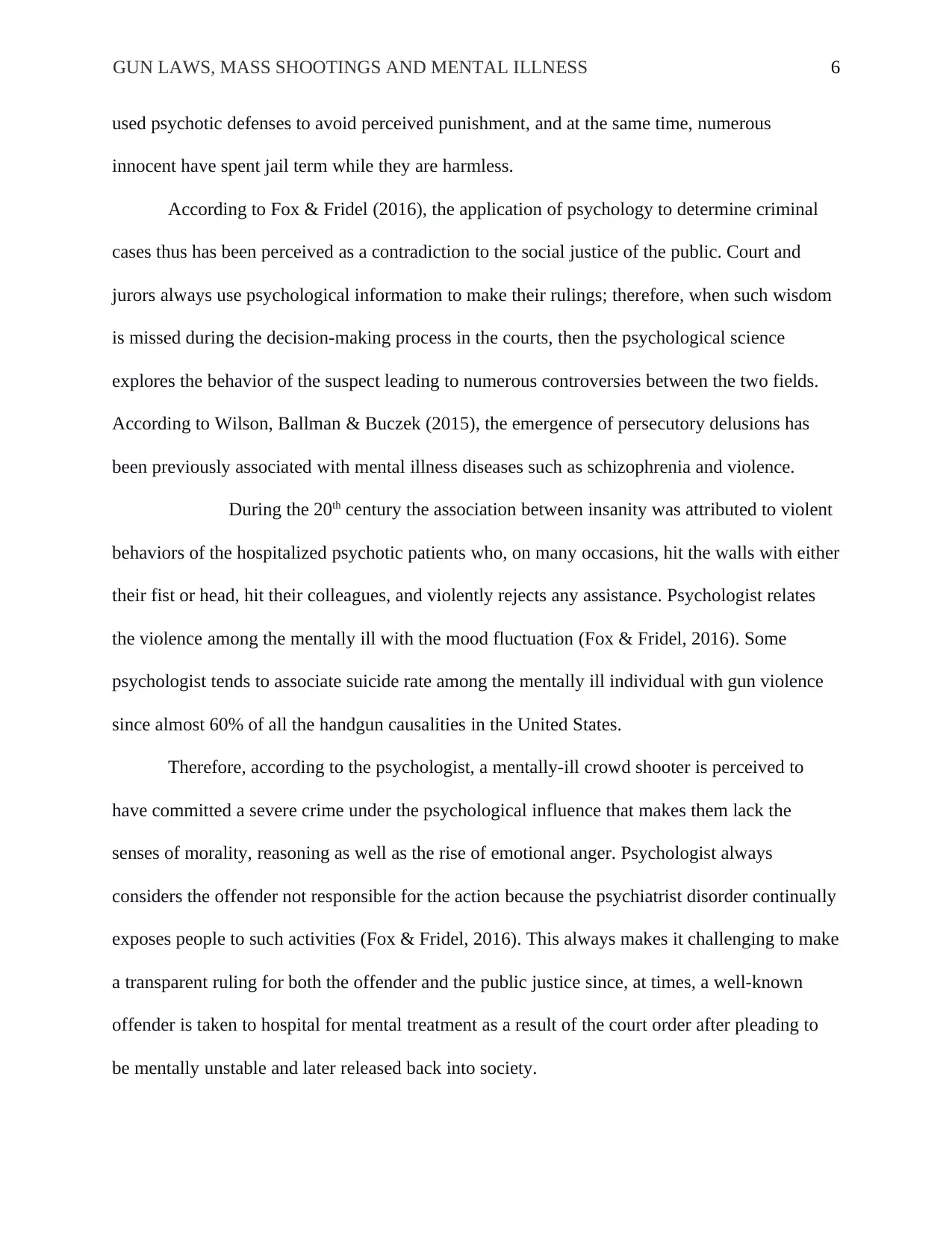
GUN LAWS, MASS SHOOTINGS AND MENTAL ILLNESS 6
used psychotic defenses to avoid perceived punishment, and at the same time, numerous
innocent have spent jail term while they are harmless.
According to Fox & Fridel (2016), the application of psychology to determine criminal
cases thus has been perceived as a contradiction to the social justice of the public. Court and
jurors always use psychological information to make their rulings; therefore, when such wisdom
is missed during the decision-making process in the courts, then the psychological science
explores the behavior of the suspect leading to numerous controversies between the two fields.
According to Wilson, Ballman & Buczek (2015), the emergence of persecutory delusions has
been previously associated with mental illness diseases such as schizophrenia and violence.
During the 20th century the association between insanity was attributed to violent
behaviors of the hospitalized psychotic patients who, on many occasions, hit the walls with either
their fist or head, hit their colleagues, and violently rejects any assistance. Psychologist relates
the violence among the mentally ill with the mood fluctuation (Fox & Fridel, 2016). Some
psychologist tends to associate suicide rate among the mentally ill individual with gun violence
since almost 60% of all the handgun causalities in the United States.
Therefore, according to the psychologist, a mentally-ill crowd shooter is perceived to
have committed a severe crime under the psychological influence that makes them lack the
senses of morality, reasoning as well as the rise of emotional anger. Psychologist always
considers the offender not responsible for the action because the psychiatrist disorder continually
exposes people to such activities (Fox & Fridel, 2016). This always makes it challenging to make
a transparent ruling for both the offender and the public justice since, at times, a well-known
offender is taken to hospital for mental treatment as a result of the court order after pleading to
be mentally unstable and later released back into society.
used psychotic defenses to avoid perceived punishment, and at the same time, numerous
innocent have spent jail term while they are harmless.
According to Fox & Fridel (2016), the application of psychology to determine criminal
cases thus has been perceived as a contradiction to the social justice of the public. Court and
jurors always use psychological information to make their rulings; therefore, when such wisdom
is missed during the decision-making process in the courts, then the psychological science
explores the behavior of the suspect leading to numerous controversies between the two fields.
According to Wilson, Ballman & Buczek (2015), the emergence of persecutory delusions has
been previously associated with mental illness diseases such as schizophrenia and violence.
During the 20th century the association between insanity was attributed to violent
behaviors of the hospitalized psychotic patients who, on many occasions, hit the walls with either
their fist or head, hit their colleagues, and violently rejects any assistance. Psychologist relates
the violence among the mentally ill with the mood fluctuation (Fox & Fridel, 2016). Some
psychologist tends to associate suicide rate among the mentally ill individual with gun violence
since almost 60% of all the handgun causalities in the United States.
Therefore, according to the psychologist, a mentally-ill crowd shooter is perceived to
have committed a severe crime under the psychological influence that makes them lack the
senses of morality, reasoning as well as the rise of emotional anger. Psychologist always
considers the offender not responsible for the action because the psychiatrist disorder continually
exposes people to such activities (Fox & Fridel, 2016). This always makes it challenging to make
a transparent ruling for both the offender and the public justice since, at times, a well-known
offender is taken to hospital for mental treatment as a result of the court order after pleading to
be mentally unstable and later released back into society.
⊘ This is a preview!⊘
Do you want full access?
Subscribe today to unlock all pages.

Trusted by 1+ million students worldwide

GUN LAWS, MASS SHOOTINGS AND MENTAL ILLNESS 7
Part B-Solutions
The erroneous uses of mental instability as a defense by numerous criminals who have
committed crowd assassinations have been rejected by both the public and the legal system as
perverse and unfounded (Nardi, 2015).Therefore, there is significant need by both legal and
psychological fields that need considerable attention to ensure that the right action is taken to
avoid the use of mental instability to commit such crimes as well as find between ways of
stopping crowd assassinations.
Redefinition of the existing mental health firearm disqualification criteria
According to Brady Handgun Violence Prevention Act, all people trying to access guns
from authorized gun sellers should undergo an evaluation to determine the eligibility of handling
a firearm. The gun dealers should compare the information provided along the registry provided
by the NICS and the mental health records (Joslyn & Haider, 2017). However, this has not
helped in denying the individual who previously had symptoms of mental illness an opportunity
to buy and own a gun as they are protected by the state law to own a gun for self-defense.
Therefore a possible recommendation for the problem of having mentally ill individuals to own
or disown a gun should be based on the capability of the state to strengthen the already existing
law. The amendment should prohibit the purchase of a firearm by the individual who either
showed short-term symptoms of mental illness or who were hospitalized involuntarily.
Expansions on the firearm rights restrictions
As discussed earlier that some crowd assassinations are always misunderstood with
mental illness since the perpetrators always have a stable mind while committing the crimes. The
United States should revise the category of individuals that are allowed to buy, possess, and own
a gun. The restrictions should entail all individuals that have been identified to have past violent
Part B-Solutions
The erroneous uses of mental instability as a defense by numerous criminals who have
committed crowd assassinations have been rejected by both the public and the legal system as
perverse and unfounded (Nardi, 2015).Therefore, there is significant need by both legal and
psychological fields that need considerable attention to ensure that the right action is taken to
avoid the use of mental instability to commit such crimes as well as find between ways of
stopping crowd assassinations.
Redefinition of the existing mental health firearm disqualification criteria
According to Brady Handgun Violence Prevention Act, all people trying to access guns
from authorized gun sellers should undergo an evaluation to determine the eligibility of handling
a firearm. The gun dealers should compare the information provided along the registry provided
by the NICS and the mental health records (Joslyn & Haider, 2017). However, this has not
helped in denying the individual who previously had symptoms of mental illness an opportunity
to buy and own a gun as they are protected by the state law to own a gun for self-defense.
Therefore a possible recommendation for the problem of having mentally ill individuals to own
or disown a gun should be based on the capability of the state to strengthen the already existing
law. The amendment should prohibit the purchase of a firearm by the individual who either
showed short-term symptoms of mental illness or who were hospitalized involuntarily.
Expansions on the firearm rights restrictions
As discussed earlier that some crowd assassinations are always misunderstood with
mental illness since the perpetrators always have a stable mind while committing the crimes. The
United States should revise the category of individuals that are allowed to buy, possess, and own
a gun. The restrictions should entail all individuals that have been identified to have past violent
Paraphrase This Document
Need a fresh take? Get an instant paraphrase of this document with our AI Paraphraser

GUN LAWS, MASS SHOOTINGS AND MENTAL ILLNESS 8
activities since most of the crowd shooters are always a result of the need to revenge (Joslyn &
Haider, 2017). Violent behavior thus should cover public and domestic violence.
Additionally, the restrictions should entail individuals that have a history of drug abuse or have
been convicted of drug abuse, or those how have reformed with a span of five years. According
to the psychologist, violent behaviors are always attributed to the drug abuse that alters mental
stability, thus causing the victims to engage in dangerous activities.
Public mental health education
To reduce crowd assassinations and gun violence, the State should develop different
educational programs to offer effective interventions to help with lessening the public fear of
mentally ill persons. Psychologists state that numerous people engage in particular behaviors as a
result of the public perception. When the public negatively perceives an individual as a result of
the health status such as mental illness or other severer diseases, the probability of such
individuals engaging in violent activities and having suicidal behaviors is always high (Fox &
Fridel, 2016). Studies indicate that mentally ill persons always face stigmatization from the
public; thus, health education on the same should be conducted. Health education has worked on
different stigmatization, such as sexual health among the teens and adolescents therefore, may
serve the same in encouraging the public to positively relate with the psychiatric individual, who
eventually will not perceive violent behaviors.
Community assessment programs
The Government, along with the community, should develop different assessment teams
that will help in identifying possible risks among the society before such an individual commits
the unthinkable. These programs should also be part of the school programs and any public
institution to help in reducing potential dangers.
activities since most of the crowd shooters are always a result of the need to revenge (Joslyn &
Haider, 2017). Violent behavior thus should cover public and domestic violence.
Additionally, the restrictions should entail individuals that have a history of drug abuse or have
been convicted of drug abuse, or those how have reformed with a span of five years. According
to the psychologist, violent behaviors are always attributed to the drug abuse that alters mental
stability, thus causing the victims to engage in dangerous activities.
Public mental health education
To reduce crowd assassinations and gun violence, the State should develop different
educational programs to offer effective interventions to help with lessening the public fear of
mentally ill persons. Psychologists state that numerous people engage in particular behaviors as a
result of the public perception. When the public negatively perceives an individual as a result of
the health status such as mental illness or other severer diseases, the probability of such
individuals engaging in violent activities and having suicidal behaviors is always high (Fox &
Fridel, 2016). Studies indicate that mentally ill persons always face stigmatization from the
public; thus, health education on the same should be conducted. Health education has worked on
different stigmatization, such as sexual health among the teens and adolescents therefore, may
serve the same in encouraging the public to positively relate with the psychiatric individual, who
eventually will not perceive violent behaviors.
Community assessment programs
The Government, along with the community, should develop different assessment teams
that will help in identifying possible risks among the society before such an individual commits
the unthinkable. These programs should also be part of the school programs and any public
institution to help in reducing potential dangers.
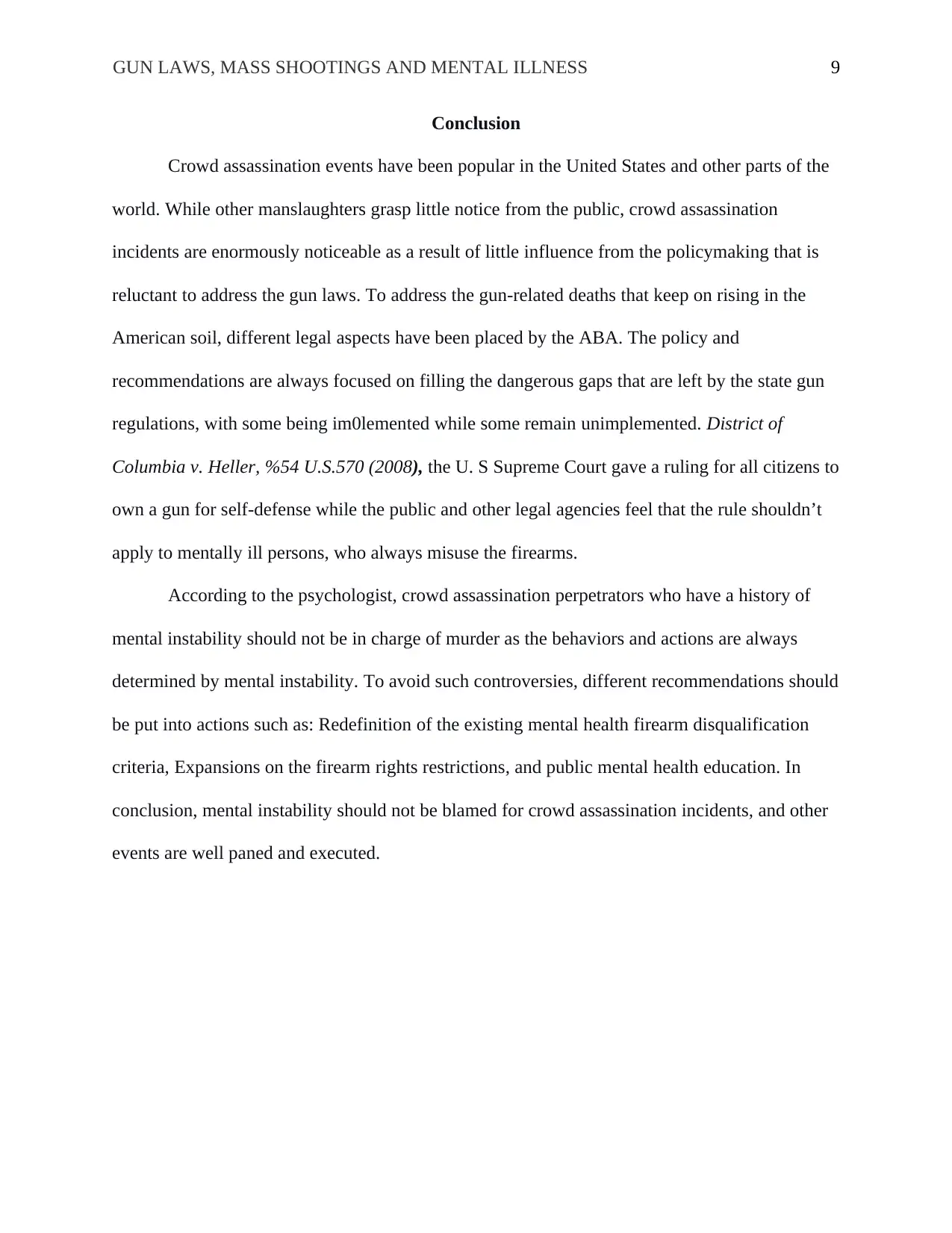
GUN LAWS, MASS SHOOTINGS AND MENTAL ILLNESS 9
Conclusion
Crowd assassination events have been popular in the United States and other parts of the
world. While other manslaughters grasp little notice from the public, crowd assassination
incidents are enormously noticeable as a result of little influence from the policymaking that is
reluctant to address the gun laws. To address the gun-related deaths that keep on rising in the
American soil, different legal aspects have been placed by the ABA. The policy and
recommendations are always focused on filling the dangerous gaps that are left by the state gun
regulations, with some being im0lemented while some remain unimplemented. District of
Columbia v. Heller, %54 U.S.570 (2008), the U. S Supreme Court gave a ruling for all citizens to
own a gun for self-defense while the public and other legal agencies feel that the rule shouldn’t
apply to mentally ill persons, who always misuse the firearms.
According to the psychologist, crowd assassination perpetrators who have a history of
mental instability should not be in charge of murder as the behaviors and actions are always
determined by mental instability. To avoid such controversies, different recommendations should
be put into actions such as: Redefinition of the existing mental health firearm disqualification
criteria, Expansions on the firearm rights restrictions, and public mental health education. In
conclusion, mental instability should not be blamed for crowd assassination incidents, and other
events are well paned and executed.
Conclusion
Crowd assassination events have been popular in the United States and other parts of the
world. While other manslaughters grasp little notice from the public, crowd assassination
incidents are enormously noticeable as a result of little influence from the policymaking that is
reluctant to address the gun laws. To address the gun-related deaths that keep on rising in the
American soil, different legal aspects have been placed by the ABA. The policy and
recommendations are always focused on filling the dangerous gaps that are left by the state gun
regulations, with some being im0lemented while some remain unimplemented. District of
Columbia v. Heller, %54 U.S.570 (2008), the U. S Supreme Court gave a ruling for all citizens to
own a gun for self-defense while the public and other legal agencies feel that the rule shouldn’t
apply to mentally ill persons, who always misuse the firearms.
According to the psychologist, crowd assassination perpetrators who have a history of
mental instability should not be in charge of murder as the behaviors and actions are always
determined by mental instability. To avoid such controversies, different recommendations should
be put into actions such as: Redefinition of the existing mental health firearm disqualification
criteria, Expansions on the firearm rights restrictions, and public mental health education. In
conclusion, mental instability should not be blamed for crowd assassination incidents, and other
events are well paned and executed.
⊘ This is a preview!⊘
Do you want full access?
Subscribe today to unlock all pages.

Trusted by 1+ million students worldwide
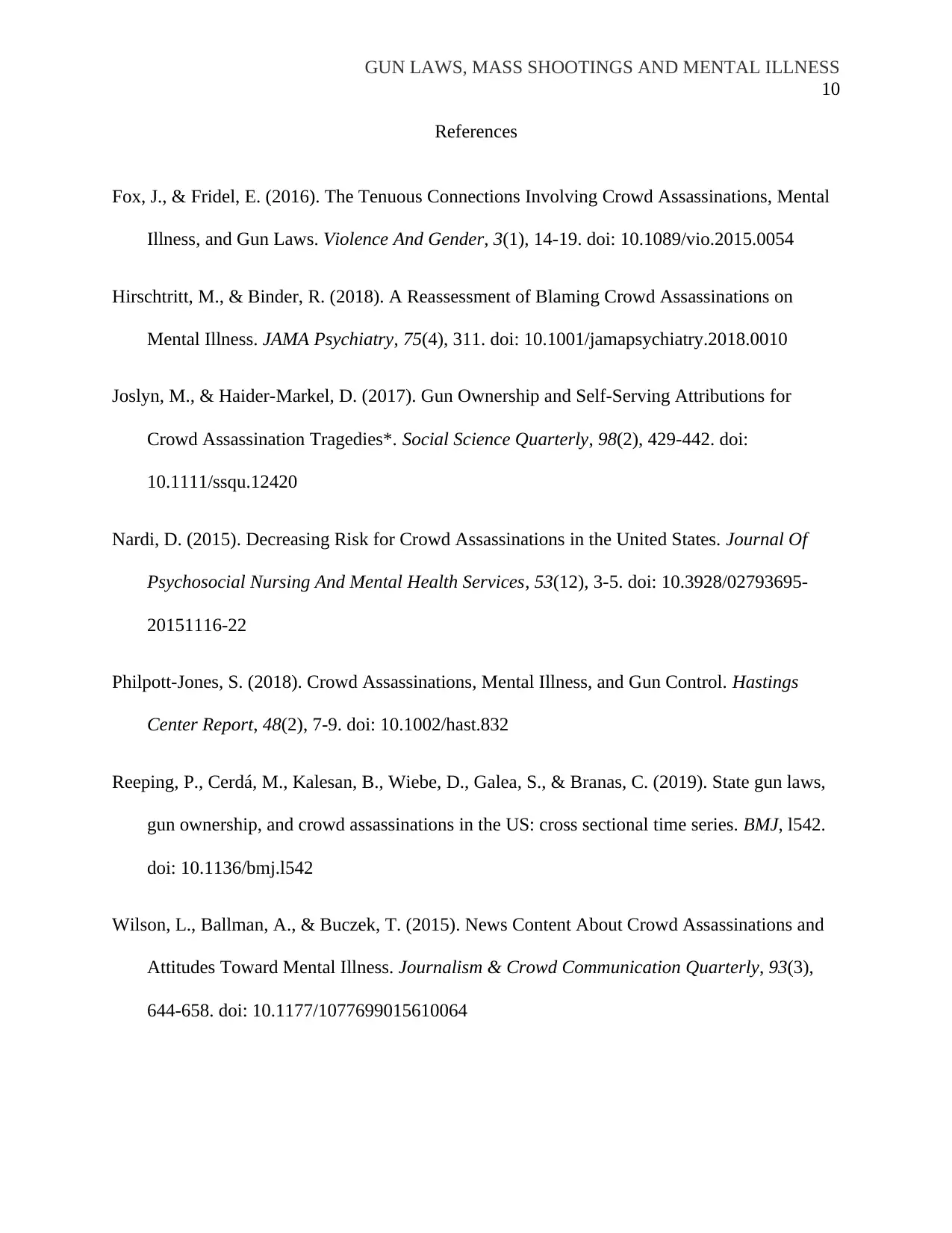
GUN LAWS, MASS SHOOTINGS AND MENTAL ILLNESS
10
References
Fox, J., & Fridel, E. (2016). The Tenuous Connections Involving Crowd Assassinations, Mental
Illness, and Gun Laws. Violence And Gender, 3(1), 14-19. doi: 10.1089/vio.2015.0054
Hirschtritt, M., & Binder, R. (2018). A Reassessment of Blaming Crowd Assassinations on
Mental Illness. JAMA Psychiatry, 75(4), 311. doi: 10.1001/jamapsychiatry.2018.0010
Joslyn, M., & Haider-Markel, D. (2017). Gun Ownership and Self-Serving Attributions for
Crowd Assassination Tragedies*. Social Science Quarterly, 98(2), 429-442. doi:
10.1111/ssqu.12420
Nardi, D. (2015). Decreasing Risk for Crowd Assassinations in the United States. Journal Of
Psychosocial Nursing And Mental Health Services, 53(12), 3-5. doi: 10.3928/02793695-
20151116-22
Philpott-Jones, S. (2018). Crowd Assassinations, Mental Illness, and Gun Control. Hastings
Center Report, 48(2), 7-9. doi: 10.1002/hast.832
Reeping, P., Cerdá, M., Kalesan, B., Wiebe, D., Galea, S., & Branas, C. (2019). State gun laws,
gun ownership, and crowd assassinations in the US: cross sectional time series. BMJ, l542.
doi: 10.1136/bmj.l542
Wilson, L., Ballman, A., & Buczek, T. (2015). News Content About Crowd Assassinations and
Attitudes Toward Mental Illness. Journalism & Crowd Communication Quarterly, 93(3),
644-658. doi: 10.1177/1077699015610064
10
References
Fox, J., & Fridel, E. (2016). The Tenuous Connections Involving Crowd Assassinations, Mental
Illness, and Gun Laws. Violence And Gender, 3(1), 14-19. doi: 10.1089/vio.2015.0054
Hirschtritt, M., & Binder, R. (2018). A Reassessment of Blaming Crowd Assassinations on
Mental Illness. JAMA Psychiatry, 75(4), 311. doi: 10.1001/jamapsychiatry.2018.0010
Joslyn, M., & Haider-Markel, D. (2017). Gun Ownership and Self-Serving Attributions for
Crowd Assassination Tragedies*. Social Science Quarterly, 98(2), 429-442. doi:
10.1111/ssqu.12420
Nardi, D. (2015). Decreasing Risk for Crowd Assassinations in the United States. Journal Of
Psychosocial Nursing And Mental Health Services, 53(12), 3-5. doi: 10.3928/02793695-
20151116-22
Philpott-Jones, S. (2018). Crowd Assassinations, Mental Illness, and Gun Control. Hastings
Center Report, 48(2), 7-9. doi: 10.1002/hast.832
Reeping, P., Cerdá, M., Kalesan, B., Wiebe, D., Galea, S., & Branas, C. (2019). State gun laws,
gun ownership, and crowd assassinations in the US: cross sectional time series. BMJ, l542.
doi: 10.1136/bmj.l542
Wilson, L., Ballman, A., & Buczek, T. (2015). News Content About Crowd Assassinations and
Attitudes Toward Mental Illness. Journalism & Crowd Communication Quarterly, 93(3),
644-658. doi: 10.1177/1077699015610064
1 out of 10
Related Documents
Your All-in-One AI-Powered Toolkit for Academic Success.
+13062052269
info@desklib.com
Available 24*7 on WhatsApp / Email
![[object Object]](/_next/static/media/star-bottom.7253800d.svg)
Unlock your academic potential
Copyright © 2020–2025 A2Z Services. All Rights Reserved. Developed and managed by ZUCOL.





